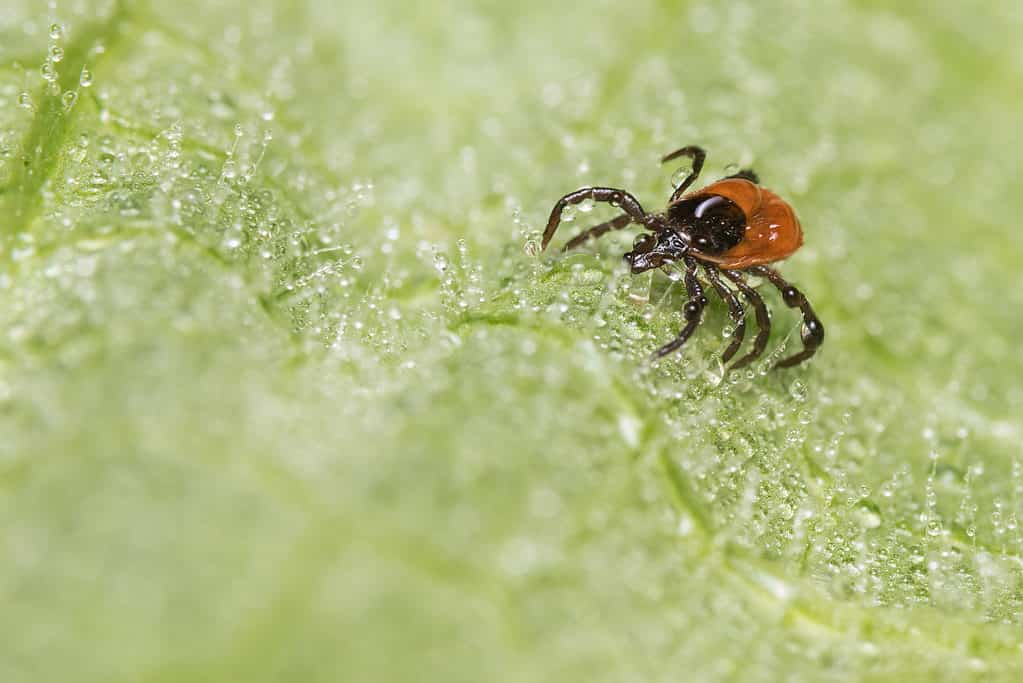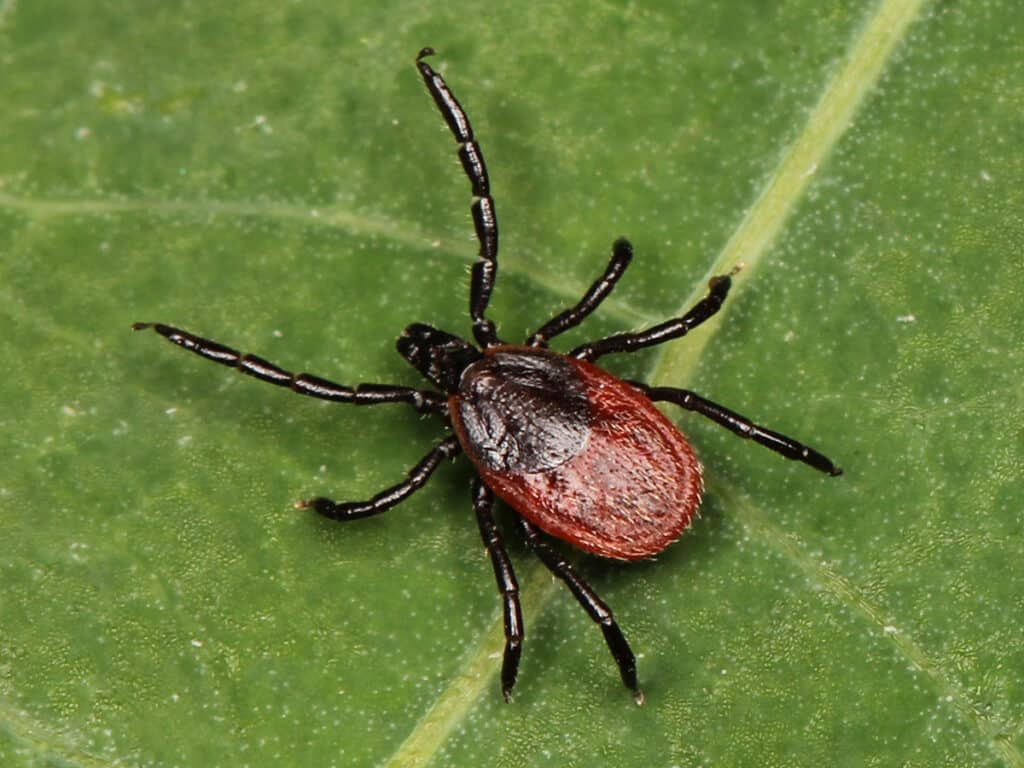Western Blacklegged Tick
Ixodes pacificus
Western blacklegged ticks are only found in the west coast of the United States
Advertisement
Western Blacklegged Tick Scientific Classification
- Kingdom
- Animalia
- Phylum
- Arthropoda
- Class
- Arachnida
- Order
- Ixodida
- Family
- Ixodidae
- Genus
- Ixodes
- Scientific Name
- Ixodes pacificus
Read our Complete Guide to Classification of Animals.
Western Blacklegged Tick Conservation Status
Western Blacklegged Tick Facts
- Name Of Young
- Larva
- Group Behavior
- Infestation
- Fun Fact
- Western blacklegged ticks are only found in the west coast of the United States
- Most Distinctive Feature
- Western blacklegged ticks do not have festoons on their back
- Distinctive Feature
- Western black legged ticks have tiny black-colored legs.
- Habitat
- Grasslands
- Diet
- Carnivore
- Favorite Food
- Blood
- Type
- Tick
- Common Name
- Western blacklegged tick
- Origin
- West coast of United States
- Location
- North America
View all of the Western Blacklegged Tick images!
Western blacklegged ticks are a species of hard ticks (ticks with hard cuticles on their backs) native to the west coast of the United States. They are ectoparasites that feed on the blood of their hosts. Apart from their parasitic nature, they are also vectors of diseases such as Lyme disease, anaplasmosis and so on. Western blacklegged ticks typically survive on blood from their host, which includes birds, lizards, deer, dogs, and sometimes humans.
Western Blacklegged Tick Species, Types, and Scientific Name
The scientific name of the western blacklegged tick is Ixodes pacificus. It belongs to the order Ixodida, a group of parasitic arachnids that survive on the blood of mammals. They’re collectively known as ticks. Ticks are further divided into two major families: the hard ticks (Ixodidae) and the soft ticks (Argasidae). The Ixodidae family, where the western blacklegged tick belongs, includes over 700 species of ticks. All members of this group are characterized by scutum, a sort of hard plate on their backs.
The word “western” is included in its common name because the arachnid only lives in the western region of the United States and Western Canada. They also have characteristic black legs as opposed to the brown ones prevalent in other species, which is why they’re called “blacklegged” ticks.

Blacklegged ticks get their name from their black legs which differ from the brown legs prevalent in other species.
©iStock.com/Ladislav Kubeš
Appearance — How To Identify Western Blacklegged Tick
Ixodes pacificus is a tiny, reddish-colored tick with hard-plated body armor on its back. Brownish-black color varieties also exist. Because it is similar to the eastern blacklegged tick, the location is a major factor in distinguishing both species. The western blacklegged tick primarily lives in the western region of the United States (especially in Northern California).
The small tick has a narrow mouthpart for sucking blood from hosts. Ixodes ticks lack festoons. This is a small groove on the tick’s back margin. While the function of this structure is not known, the absence of festoons is a major distinguishing feature for identifying blacklegged ticks.
Ticks are arachnids, so they tend to have eight thin appendages. The nymphs have only six legs, and the last two only develop as the species grows. A mature female western blacklegged tick is as small as 0.13 inches without food. It tends to grow slightly bigger after feeding (the female can grow as big as 0.37 inches). The adult male, on the other hand, is significantly smaller. It is just about 0.1 inches big. However, male western blacklegged ticks can’t grow bigger. The dorsal position of their scutum does not allow them to feed too much. This also implies that they do not swell up after feeding. The nymphs are less than 0.04 inches in size and are mainly found on lizards and birds.

The western blacklegged tick (
Ixodes pacificus) are a species of hard ticks native to the western region of the United States with black legs.
Habitat — Where To Find Western Blacklegged Tick
Ixodes pacificus lives primarily in the western region of the United States and Western Canada. In the US, it is mainly found in California. The state has 58 counties, and blacklegged ticks have been recorded in 56 of them. However., its range also includes other western states like Oregon, Utah, Arizona, and Washington.
Densely populated woodlands are the preferred habitat for western blacklegged nymphs. This is the stage where they start to look for hosts. You can find them under fallen leaves and tree branches, or logs.
The mature adult tick is mostly found in areas with thick and long vegetation, like grasslands. You can find these creatures on different parts of the plant, especially on the leaves.
Evolution and History
The evolution of ticks, like most animals, is a little difficult to trace. There are still many uncertainties about the subject, and scientists have had to make several assumptions about tick evolution.
Different times have been proposed for the possible evolution of the ticks. One group of scientists believes that the origin of ticks goes way back to the Devonian Period (about 400 million years ago). Their ancestors were probably parasitic species that resembled mites. These creatures lived off the first amphibians to venture out of the water. One piece of evidence to support this is the presence of a tick species (Amblyomma rotundatum) that attaches itself to the body of the neotropical giant toad.
Scientists have put forward other timelines for tick evolution, including the late Permian and Triassic periods. Many other scientists believe ticks came into existence even more recently. Scientists propose that tick ancestors originated 100 million years ago during the Cretaceous. The oldest fossils of Acariform mites date back to the Devonian (about 410 million years ago). However, the oldest hard-bodied tick found in fossil records dates back almost 90 to 94 million years. This implies that this branch of the tick family branched off about 120 million years ago. Scientists are still uncertain of the reason why hard and soft ticks evolved differently.

Scientists propose that tick ancestors originated 100 million years ago during the Cretaceous.
©daksel/Shutterstock.com
Diet — What Do Western Blacklegged Ticks Eat?
The entire life cycle of a tick is in four stages: the egg, larva, nymph, and finally, the adult. Ticks must feed to survive each of the stages after they hatch. They are parasitic insects that primarily feed on blood. They also need to switch hosts as they progress into their next life stage. Mature western blacklegged ticks feed on larger hosts like deer and humans. They are so prevalent among deer that they are also called deer ticks. Younger ticks prefer birds, rodents, and lizards.
The tick uses its palp to find a suitable host and secures itself in a comfortable spot for feeding. It pierces the skin of the host, secreting saliva as it does. The saliva numbs the stinging sensation caused, so the host is unaware of the insect’s presence. After the piercing, the parasite inserts its hypostome (barbed feeding tube) into the host. The feeding can go on like this for days.

Mature western blacklegged ticks are so prevalent among deer that they are also called deer ticks.
©iStock.com/Harry Collins
Prevention — How To Get Rid of Western Blacklegged Ticks
Western blacklegged ticks are carriers of various disease pathogens. They transfer the pathogens into the unsuspecting host as they feed. Lyme disease and anaplasmosis are some deadly sicknesses these parasitic insects transmit. Humans and pets have an increased risk of exposure to ticks after contact with shed leaves and tree logs. Humans can also get them indirectly from their pets.
The best way to prevent diseases transmitted by ticks is to eliminate these parasites. The most effective prevention is to maintain a clean and healthy environment. Put some effort into getting rid of weeds and dirt since these are potential nesting grounds for tick nymphs.
You may also spray your gardens and yards with pesticides, especially if you live in an area where the tick is rampant. Use appropriate repellents for yourself and your pets. Permethrin, or DEET (a brand of diethyltoluamide), is very effective in preventing ticks. Permethrin stops western blacklegged tick bites through paralysis while DEET repels them.
Wearing light-colored clothes makes it easy to detect these ticks since their natural color is dark. The color contrast makes it easy to spot and get rid of them adequately. If you allow your pets to roam outdoors, inspect their coats for ticks and treat them accordingly.
Related Animals
View all 108 animals that start with WWestern Blacklegged Tick FAQs (Frequently Asked Questions)
Are western blacklegged ticks dangerous?
Yes, they are. They are host to several dangerous pathogens. They are also major carriers of the pathogens that cause Lyme disease.
How many legs do western blacklegged ticks have?
It depends on their maturity stage. Western blacklegged ticks have six legs at the nymphal stage and eight legs when they reach adulthood.
How do you identify the western blacklegged tick?
These ticks are very similar to the eastern blacklegged ticks (Ixodes scapularis). Western blacklegged female ticks have a deep red or brownish cuticle on their backs, with an orange underside. The differences between both species can be spotted more visibly when you observe them under the microscope.
How do you get rid of the western blacklegged tick?
Keep your garden neat and well-trimmed. Carefully inspect your clothing and monitor your pets when they are outdoors. Dress appropriately and use permethrin insecticide or DEET repellent. If you encounter one on your skin, firmly pull it out with tweezers.
Do all blacklegged ticks carry Lyme disease?
Even though most of these parasites are bad news, not all of them carry the pathogen of Lyme disease. The average percentage of blacklegged ticks that transmit the condition is only 20%. However, the figure can be as high as 75% in certain regions.
What makes the western blacklegged tick unique?
Both the western and eastern species of blacklegged ticks look alike. However, the main distinguishing feature is the absence of abdominal festoons in the western blacklegged ticks.
Thank you for reading! Have some feedback for us? Contact the AZ Animals editorial team.
Sources
- Igenex / Accessed January 3, 2023
- Wikipedia / Accessed January 3, 2023
- Scientific American / Accessed January 3, 2023
- Oregon State University / Accessed January 3, 2023
- PestWorld.org / Accessed January 3, 2023


















